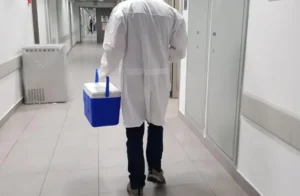The first transplantation of the mesenchymal stem cells (MSC) was given as part of compassionate treatment to a two-and-a-half-year-old boy suffering from epidermolysis bullosa (EB).

Tel Aviv Sourasky Medical Center’s Institute for Advanced Cell Therapy (I-ACT) has completed the development of the production process for a certain type of stem cell that allows it to be transplanted into a patient with a rare, skin blistering disease, as part of the first advanced cell therapy of its kind in Israel for it – and the first outside the US.
The first transplantation of the mesenchymal stem cells (MSC) was given as part of compassionate treatment to a two-and-a-half-year-old boy suffering from epidermolysis bullosa (EB). It was found that the cells are able to provide the same collagen VII that is missing in EB, thus helping to heal the skin and prevent the appearance of new blisters.
The condition was brought to public attention in 2004 in the UK by the Channel 4 documentary The Boy Whose Skin Fell Off, chronicling the life and early death of Jonny Kennedy, an Englishman with EB, a group of rare diseases that cause the skin to blister easily.
The blisters quickly burst because the skin is so fragile, leaving slow-healing wounds. Such fragile skin is usually noticeable at birth. A hug, rub on the back or diaper change can injure the skin, leading to blisters and open wounds.
What is EB and how does it come about?

EB is caused by mutations within the human COL7A1 gene encoding the protein type-VII collagen.
The baby’s treatment is being carried out in collaboration between Prof. Ronit Elhasid, director of the pediatric hemato-oncology department at Sourasky’s Dana-Dwek Children’s Hospital, and Dr. Liat Samolov, of Sourasky’s Dermatology Department.
How does the treatment work?

In the first stage, the young patient receives a bone marrow transplant from a compatible donor, followed by three treatments with MSCs produced under sterile conditions from the same donor at predetermined time intervals. The stem cells were produced under sterile conditions in I-ACT’s clean rooms.
Some children develop blisters in the moist tissue that lines the mouth, throat, stomach, intestines, rectum and other areas of the body. In these areas, the friction caused by swallowing food or having a bowel movement can lead to painful blisters.
As blisters heal, scars appear. This can cause the toes or fingers to join together, but taking precautions can reduce the risk of this happening. People with EB have compared the sores with third-degree burns.
Furthermore, as a complication of chronic skin damage, sufferers have an increased risk of skin cancer. The disease is accompanied by great suffering, and causes severe functional impairment; in some cases, it may even lead to death at a young age.
MSCs are multipotent stem cells found in the bone marrow that can differentiate into other types of cells and are important for making and repairing skeletal tissues such as cartilage, bone and the fat found in the bone marrow. With age and disease, they predominantly convert into lipid-accumulating fat cells.
Stem cells are divided into two types: embryonic stem cells, which play a central role in the earliest stages of development of the fetus, and MSCs, which originate from various tissues that contribute to the renewal and construction of adult-body tissues.
The human skin consists of two layers – an outermost layer called the epidermis and a layer underneath called the dermis. In people with healthy skin, there are protein anchors between these two layers that prevent them from moving independently from one another, but in babies born with EB, the two skin layers lack these protein anchors that hold them together, resulting in extremely fragile skin.
As of today, the only stem cells that have passed the experimental stage and been approved for widespread medical use in humans are MSCs from bone marrow.

